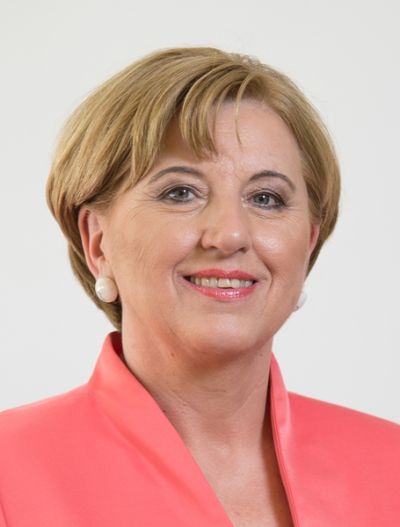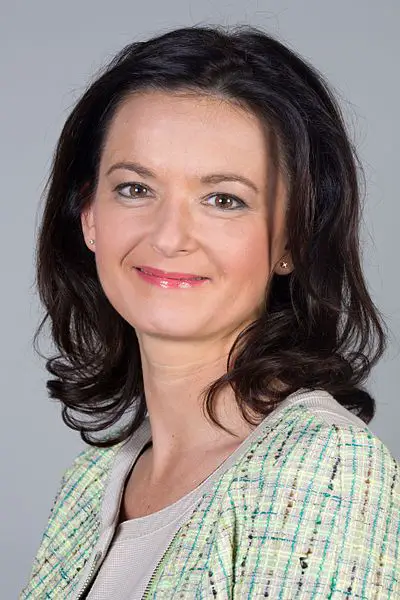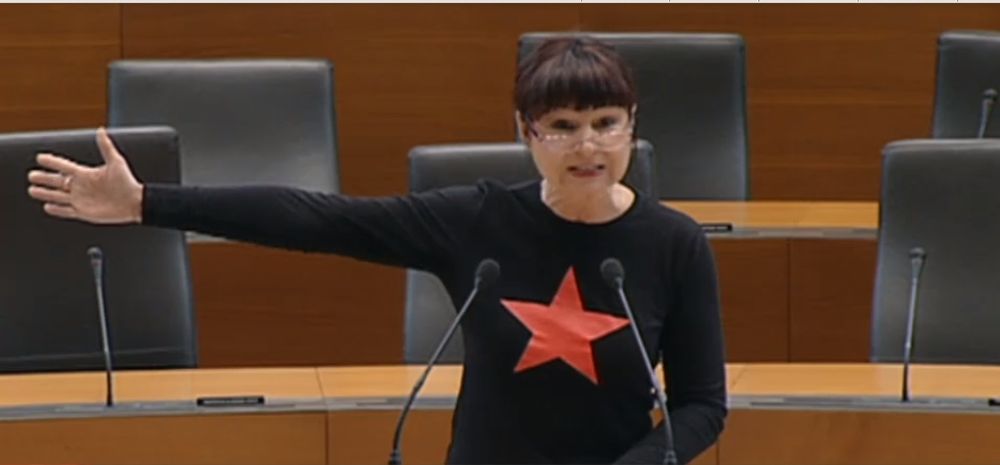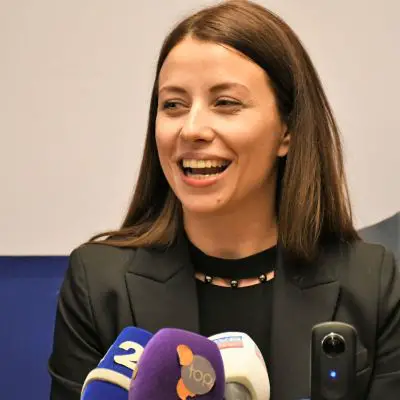Ljubljana related
STA, 23 April 2019 - With turnout at European Parliament elections exceptionally low - under 25% in 2014 - the path to success hinges on mobilising core constituents in the weeks leading up to polling day. This will also crucially inform the substance of the debate, according to political analysts.
Mobilisation of decided voters will be key, says Alem Maksuti of the Institute of Political Management, a private think-tank. This gives established parties an advantage.
Addressing the hard core of constituents will be instrumental, and this is most easily achieved with field work, which plays to the advantage of established parties, according to Rok Čakš, a columnist for the conservative portal Domovina.je.
This is also why the campaign is unlikely to feature substantive debates on the future of the EU.
Related: How to Vote in the 2019 EU Elections in Slovenia
"I'd be glad if debate about pressing issues concerning the shared future in the EU is more substantive and less populist this time, but knowing the Slovenian political and media reality, this is overly optimistic," Čakš told the STA.
Maksuti likewise believes there will be no room in the campaign for the future of the bloc. Instead, the focus will be on the parties and their candidates.
"Politics is on the back burner here. Since the parties are relatively similar and pursue a practically identical policy, I don't expect substantive differences," he said.
But despite the focus on personalities, many parties old and new have fielded weak candidates overall, according to Maksuti.
He thinks that party affiliation will be the key factor determining success, with individual names less important, with the exception of MEPs, who are "already stored in people's brains".
Čakš thinks that some parties, in particular the Democrats (SDS), Social Democrats (SD) and New Slovenia (NSi) have put together strong slates and are offering "people who understand what the EU is about".
Newer parties, meanwhile, are concealing their lack of substance with "polished images, apt public appearances and the repetition of general, principles populist sentences".
As regards the campaigning techniques, Čakš believes that TV debates will remain the biggest media events, while social networks will be "cheap support for all other activities."
Maksuti, meanwhile, thinks tools such as debates are less relevant, even as they are often ascribed significant importance.
Turning to the likely outcome, Čaks said fragmentation on the left could cost the left-liberal bloc an MEP seat at the expense of the opposition Left or the centre-right.
Maksuti believes the distribution of votes will be very similar than four years ago, in particular for established parties.
In 2014 conservative parties that are members of the European People's Party (EPP) got five of the eight MEPs allocated to Slovenia, with liberal and left parties getting three.
All our stories on the EU elections are here
STA, 15 April 2019 - Slovenian MEPs have been active in a number of different fields in the past five-year term. The eight of them listed for the STA their achievements, reflecting above all their work in parliamentary committees. Among other things, each of them has been a member or a substitute member of a committee dealing with issues of the Western Balkans.
Ivo Vajgl (ALDE/DeSUS) was among the most active Slovenian MEPs as regards foreign policy and the Western Balkans. He highlighted his efforts as the European Parliament rapporteur for Macedonia, "which we helped steer onto the European path".
Vajgl, who will not run again this year, was also a member of a task force dealing with issues of the elderly, which managed to get this topic onto the parliament's agenda.
Together with Igor Šoltes (Greens), who will succeed Vajgl on the ticket of the Pensioners' Party (DeSUS) in May election, Vajgl nominated the programme Elderly for the Elderly for the Citizen of Europe 2017 award.
The project, which went on to win the award, "includes what is often missing in Europe: empathy, solidarity and true humanity," said Šoltes, who has also been active in the fields of environmental and consumer protection, filing a motion to exclude food orders from the public procurement system in order to serve locally-grown food in schools, hospitals and retirement homes.
Romana Tomc of the (EPP/SDS) is proud of her "fight of the small against the big", as her warnings had led to the launch of infringement procedure against Austria for cutting child benefits for Slovenians working in Austria.
Tomc also strived against youth unemployment and highlighted her work in an investigative committee that looked into money laundering at the Slovenian bank NLB.
Her party colleague Patricija Šulin (EPP/SDS), a member of the budgets committee, was also active in the field of finance, serving as member of the parliament's delegation in talks with the European Commission and the European Council.
She also highlighted that she managed to speed up the drafting of a report that provided Slovenia EUR 18m in funds following an ice storm that devastated much of Slovenian forests in 2014.
Tanja Fajon (S&D/SD) told the STA that she acquired for Slovenia additional EUR 70m in the next financial perspective to improve border security and migration management.
"Slovenia has a long Schengen border and long traffic jams and we will try to reduce this burden, while on the other hand ensuring that Schengen is preserved," Fajon told the STA, adding that she was also fighting against "current illegal practices of border controls within the Schengen zone, such as those between Slovenia and Austria."
Franc Bogovič (EPP/SLS) is dedicated to regional development issues, being a member of the regional development committee. He campaigned for the launch of the Smart Villages pilot project, which aims to stop the young moving from the countryside and against the trend of people moving from the less to the more developed parts of the EU.
"The regional development fund will provide EUR 13.5bn for this field and EUR 2.4bn for smart villages," said Bogovič, expressing pride in what he has achieved.
Milan Zver (EPP/SDS), a rapporteur for the culture and education committee, highlighted as one of his biggest achievements a threefold increase in funds for the Erasmus exchange programme. "I find this very important because there has always been too little money when it came to Erasmus and youth policy."
He is also happy that one of the conference halls at the parliament has been named after Slovenian dissident Jože Pučnik.
Lojze Peterle (EPP/NSi) meanwhile said he was proud to have enabled a paid internship at the parliament for 60 youths. He also contributed to the decision of the EPP to make cancer one of its priorities in the next term.
All our stories on this year's EU elections, including details of how to vote, can be found here
STA, 15 April 2019 - Slovenian members of the European Parliament tend to vote in accordance with their Eurogroup, and have high attendance in votes in plenary meetings of the European Parliament, data from VoteWatch show.
Patricija Šulin (EPP/SDS) has attended 95% of votings in the European Parliament, ranking her first among Slovenian MEPs. Tanja Fajon (S&D/SD) ranked last, at 82%. Slovenian MEPs' attendance averages about 90%.
Other parliamentary duties may cause MEPs to be absent from votings, according to VoteWatch. This is why Antonio Tajani, the President of the European Parliament, "only" attended 38% of the votings. This, however, is not an accurate measure for their activity and achievements.
Slovenian MEPs are extremely loyal to the political opinions of their Eurogroup. On average, they agree on around 96% of issues. The only discrepancy is Ivo Vajgl (Alde/DeSUS) whose agreement measures at around 90%.
Slovenia has five MEPs in the European People's Party (EPP), and one each in the Progressive Alliance of Socialists and Democrats (S&D), the Alliance of Liberals and Democrats for Europe (ALDE), and the Greens.
Tanja Fajon is the only Slovenian to be featured on VoteWatch's list of 70 most influential MEPs, probably because of her work as the vice-president of the S&D group. According to the site, Slovenian deputies seem to be the most influential in policy matters concerning the Western Balkans.
MEPs' activities can be tracked through two main web-based tools, VoteWatch and MEPranking, each of which relies on a different set of methods. Both have come under fire in the past because of their methodology.
Some MEPs were among the critics, arguing that arbitrarily quantifying their activity was not an accurate measure for their work.
On the other hand, these tools allow citizens of the European Union to view their elected representatives' activity and compare their voting with their own stance on issues, among other things.
More data on this can be found here
All our stories on this year's EU elections, including details of how to vote, can be found here
STASTA, 15 April 219 - Slovenian voters have gone to the polls to elect MEPs three times so far - in 2004, 2009 and 2014, with most of the support in all three elections going to parties belonging to the European People's Party (EPP). The only Slovenian to win an MEP seat in all three elections is Lojze Peterle of New Slovenia (NSi/EPP).
Slovenia joined the EU in May 2004 and its voters had the opportunity to elect seven MEPs a month later, with centre-right parties winning the 13 June elections convincingly.
EPP members got four seats as Slovenians elected Lojze Peterle and Ljudmila Novak from the NSi, and Miha Brejc and Romana Jordan Cizelj from the Democrats (SDS).
The remaining three MEPs were Jelko Kacin and Mojca Drčar Murko from the Liberal Democrats (LDS), who joined the Alliance of Liberals and Democrats for Europe (ALDE), and Borut Pahor from the Social Democrats (SD), who joined the Party of European Socialists (PES).
The NSi won most of the vote (23.6%), followed by a joint ticket of the LDS and the Pensioners' Party (DeSUS) with 21.9%, the SDS with 17.7% and the SD with 14.2%.
The group associating conservative and centre-right parties was also the winner at the EU level, wining a total of 272 seats in the 732-member European Parliament.
Turnout in Slovenia (28.4%) was significantly lower than in the 25 EU member states on average (45.5%).
In 2009, when the European Parliament elections were held in 27 countries, members of the EPP also won most of the vote, with the SDS getting 26.7% of the vote, followed by the SD (18.5%), the NSi (16.5%), the LDS (11.5%) and Zares (9.8%).
Elected as MEPs were Romana Jordan Cizelj and Milan Zver (EPP/SDS), Lojze Peterle (EPP/NSi), Zoran Thaler and Tanja Fajon (PES/SD), Jelko Kacin (ALDE/LDS) and Ivo Vajgl (ALDE/Zares).
Thaler resigned in 2011 after journalists posing as lobbyists exposed him as one of four MEPs accepting the offer of a bribe in exchange for tabling amendments in the European Parliament. He was replaced by Mojca Kleva (PES/SD).
The EPP also won the elections at the EU level convincingly, getting 263 MEPs in the 736-seat European Parliament.
As the European Parliament was enlarged in December 2011 with changes to the Lisbon Treaty, Slovenia received an additional, eighth seat, which went to Zofija Mazej Kukovič from the SDS.
In addition to the extra seats, changes to the treaty also brought certain restructuring of political groups, with the EPP having a total of 274, the Progressive Alliance of Socialists and Democrats (S&D) 195 and ALDE 85 MEPs at the end of the term.
While turnout in Slovenia remained almost flat at 28.37%, it dropped somewhat in the EU as a whole (42.97%).
The 2014 EU elections, which were held in 28 member states as Croatia joined the bloc the year earlier, were marked by a rise of Eurosceptics and ALDE losing the third place in the European Parliament to the European Conservatives and Reformists (ECR).
Out of the total of 751 MEP seats, the EPP got 221 and the S&D 191, while following far behind were the ECR (70) and ALDE (67).
In Slovenia, the EPP again won most of the vote, with the SDS winning three seats, for Milan Zver, Romana Tomc and Patricija Šulin, and the People's Party (SLS) and the NSi winning one each, for Franc Bogovič and Lojze Peterle, respectively.
In addition to Zver, elected for their second terms were Tanja Fajon (S&D/SD) and Ivo Vajgl, who ran on the ticket of DeSUS, while also making it to the European Parliament was Igor Šoltes, who ran with his own party Believe.
The SDS received 24.8% of the vote, followed by the joint ticket of the NSi and the SLS (16.6%), Believe (10.3%), and the SD and DeSUS (around 8% each).
The declining turnout trend continued, reaching record-lows of 42.6% at the EU level and 24.5% in Slovenia.
All our stories on this year's EU elections, including details of how to vote, can be found here
March 7, 2019
With regard to the name that will compose party lists in the upcoming European parliamentary elections, we know now that at least four major parties chose women as heads of their lists of candidates. Since the voting system allows voters to also cast a preferential vote to one of the candidates on the list they are choosing, being no. 1 on the list doesn’t necessarily mean you are first to get a parliamentary seat but rather that you serve as a face of that list, and will almost certainly participate in election debates.
So far the lists have been presented by Nova Slovenija (NSi), Socialni demokrati (SD), Levica and most recently also the Prime Minister’s Lista Marjana Šarca (LMŠ), who surprised with some very fresh faces, a bit too fresh, some might say.
Soon Slovenska Demokratska Stranka (SDS) is expected to present their list of candidates, and if they decide to put the current European Member of Parliament Romana Tomc at the head of the list, this would be the fifth woman in such a position so far.
Although women are usually allowed to lead in times of crisis (the so-called “glass cliff”, as seen with Alenka Bratušek becoming prime minister during the peak of the last financial crisis, of Theresa May taking charge after the Brexit vote) or when no chance of winning is in sight (five women were pushed into the race against the incumbent and very popular President Borut Pahor who was running for a second term in 2017). With few exceptions this time the female candidates are strong and experienced politicians, with, hopefully, good chances of winning their European Parliament seats, which continues to be seen as an honorable and well-rewarded job.

NSi: Ljudmila Novak, one of the strongest female politicians in the country and former party president, managed to beat her party colleague, current member of the European Parliament and one of independent Slovenia’s first generation of politicians, Lojze Peterle, at the top of the list. With Ljudmila at the top, Lojze fell to no. 3.

SD: Tanja Fajon, current Member of the European Parliament. One of most active and recognisable Slovenian politicians serving in Brussels.

Levica: Violeta Tomič. The former actress is one of the strongest female politicians in Slovenia, and also one of the two transnational spitzenkandidaten of the oppositional “European Left”.

LMŠ: Irena Joveva, a 30 year-old journalist without any political experience.
While recent polls suggest strong popular support for Marjan Šarec List (LMŠ) it remains to be seen how this latest choice might affect the party’s popularity. So far the group’s success has been mainly based on the charisma of its leader and the current Prime Minister, Marjan Šarec.
At the press conference on Monday Šarec explained his party’s choice of candidates with the following words: “This is like sending a song to the Eurovision song contest. It is difficult to know what the winning formula might be.”
March 4, 2019
Are you an EU citizen who recently received a letter from the Ministry of Interior in Slovenian but have no idea what it says?
In case you don’t understand Slovenian, here you can find the same document in English.
In short, by filling it out and sending it to the Ministry’s address, you are registering yourself in Slovenia for the upcoming EU Elections, to be held Sunday, May 26, and allowing the Ministry to inform your home Member State that you should be taken out of their voter registry.
The Ministry’s website states that the electoral rolls will be completed on May 10 2019, so if you’d like to exercise your right to vote in the Republic of Slovenia then fill in the form and send it to the Ministry as soon as possible.
Note that if the UK leaves the EU before July 1 2019, when the newly election MEPs will join the European Parliament, then Britain will not be holding these elections and UK nationals will not be able to vote anywhere in the EU. However, if there is an extension to the process, and thus the UK remains an EU member state beyond July 1, then Britain will need to organise elections. If it doesn’t, then the new European Parliament will be sitting without MEPs from all member states, leaving any decisions it makes open to legal challenge. As such, if you’re a UK national then keep this document and send it to the Ministry if it becomes clear that Britain will be holding European elections, a matter that should receive considerable media attention.
March 1, 2019
Non-Slovenian EU citizens can either vote for their EU representatives in their country of origin or in their country residence, but not both.
If you decide to vote for your representatives in Slovenia, we will keep you posted on the lists of candidates once they are agreed upon by the political parties. The lists have to be filed by the 26th of April, which is also the beginning of the official election campaign.
Across Europe voters will cast their votes between 23rd and 26th of May, in Slovenia elections are always held on Sunday, meaning the main Election Day is on the 26th of May. In case you are planning to go for a trip that Sunday, it is also possible to cast your vote on the 21st 22nd or 23rd of May at the headquarters of your area’s voting committee.
Each voter can only vote for one of the lists (a set of candidates from one or more parties, if the parties decide to cooperate) on the ballot, on which they are also allowed to cast a preferential vote for one of the list’s candidates.
For more details click here.
STA, 13 February 2019 - President Pahor has called elections to the European Parliament for 26 May, initiating formal procedures leading up to the vote.
This year's elections to the European Parliament will take place across the continent between 23 and 26 May. Since Slovenia holds elections on Sunday, the only possible date is 26 May.
The writ issued on Wednesday means candidates will be able to formally register starting on 25 February, with the election campaign officially starting a month before voting day.
Pahor said he will not intercede in the campaign directly but will "dare to emphasise as president of the republic how important the EU is for our national interest."
This year's election could chart the course of future development of the EU, either in the direction of stronger integration or towards a smaller and weaker EU. This is why it is important that Europeans vote on the fate of the common European home.
"The results of our will need to be understood and respected after the election. This is why these elections ... are particularly important," he said.
Outlining the political landscape months before the vote, Pahor said the EU was experiencing a hiatus that has led to popular discontent and hence given rise to ideas for a loosening of integration and a "return to national frameworks".
But this does not bode well for Slovenia since it marks a "return to the old European geopolitics, which strengthens what divides us rather than what brings us together."
"The nurturing and development of the common European home guarantees peace, security and prosperity, its demise would jeopardise all that," he said.
Confused about the elections? The Wikipedia page is here with the basic facts and figures




